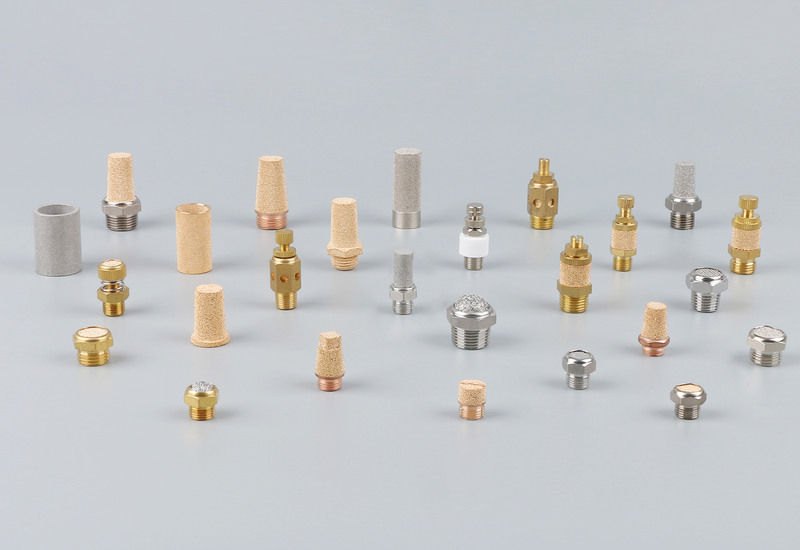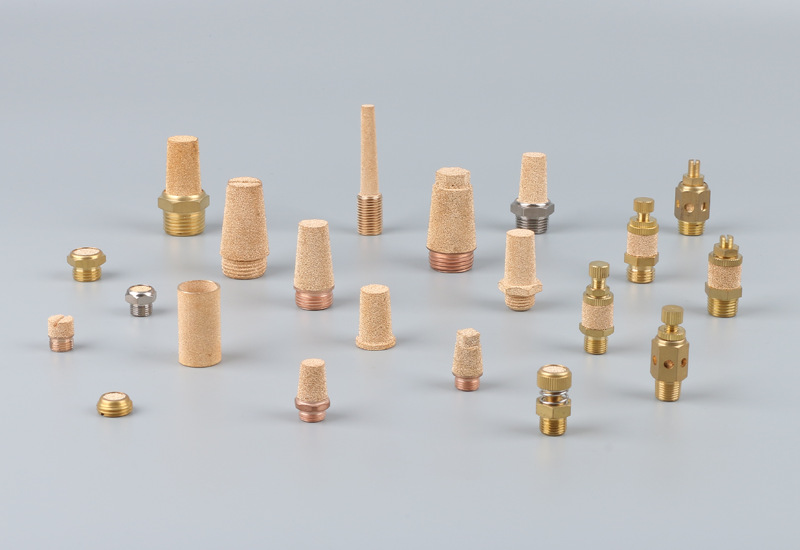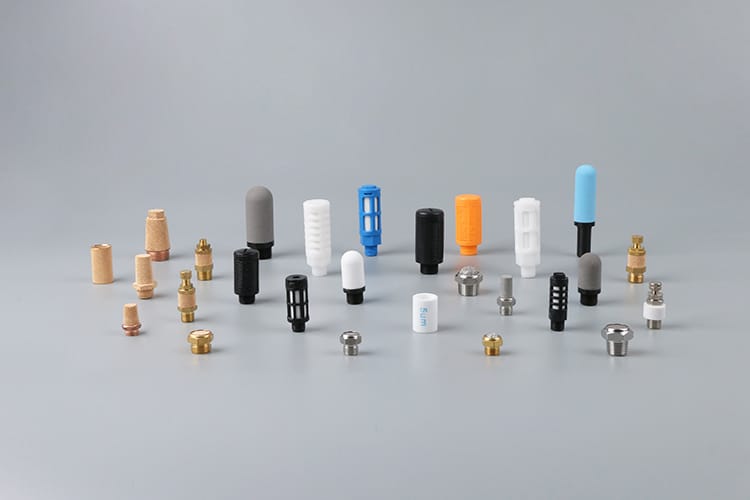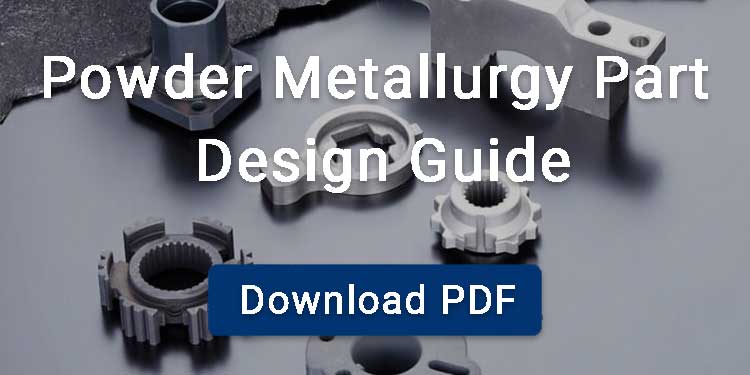Sintered filter is a porous device that is formed by mixing powder and then sintering. A sintered filter has an interconnected microporous structure that captures particulate impurities and offers high filtration efficiency.
These porous filters not only function as filters but also serve various purposes such as flow restrictors, pneumatic silencers, diffusers, and more. They are available in cylindrical, conical, and disc shapes.

Contents
Types of Sintered Filter
According to the materials, sintered filters can be divided into the following types.
Sintered Metal Filter
Porous metal filter elements are made by fusing metal powder particles.
Here are some common sintered metal filters.
Sintered Stainless Steel Filter
Sintered stainless steel filters have good corrosion resistance, high strength, and good high-temperature resistance. So they have the capability to withstand corrosive environments and harsh environments.
Porous filters are available in materials such as 316L, 304L, 310, and 430.

Sintered Bronze Filter
Sintered bronze filters have good corrosion resistance and thermal conductivity. So you may see them in hydraulic and pneumatic systems.

Sintered Titanium Filter
Sintered titanium filters are popular due to their high strength, lightweight, and corrosion resistance.
Sintered Nickel filter
These Porous nickel filters are renowned for their good magnetic properties. Besides, nickel filters are available in Inconel 600, 625, and 690.
Sintered Plastic Filter
Porous plastic filters are featured by their light weight, corrosion resistance, and low cost. The raw materials used include PE, PP, and UPE.

Sintered Ceramic Filter
Sintered ceramic filters excel in withstanding high temperatures and maintaining stability, making them ideal for filtering molten metals. They are also highly effective in filtering air and water.
Sintered Glass Filter
what is sintered glass filter?
Glass filter is manufactured from glass powder, such as borosilicate glass. Glass filter is easy to clean and do not shed fibers.
Sintered glass filter is mainly applied in laboratories and the biomedical industry.
The following table is about the filtration accuracy and working temperature of sintered filters of different materials.
| Material | Filtration Ratings (pore size) | Operating Temperature |
|---|---|---|
| Bronze | 5-100μm (20-180μm) | Not exceeding 300°C |
| 316 Stainless Steel | 0.50-80μm (10-160μm) | No more than 600°C |
| Titanium Alloy | 0.50-50μm (10-100μm) | No more than 300°C |
| PP Plastic | 0.50-100μm (10-180μm) | Less than 80°C |
Sintered Filter Working Principle
Gas & Liquid Filtration
Sintered metal filters can remove sediment, metal fragments, algae and other contaminants from liquids or water. There are several filtering mechanisms.

Surface Filtration
Sintered filters are porous structures, and larger particles are blocked on the surface of the filter. This is to remove larger particle pollutants and prevent clogging of the internal pore structure.
Deep Filtration
The pores inside the filter are tortuous and interconnected, and smaller particles will be adsorbed into the internal pore wall of the filter during flow.
Diffusion Filtration
The fine particles in the gas will diffuse onto the internal pore walls when passing through the filter. Thus achieving the filtering effect.
Breather Vents
Breather vent allows for pressure equalization and prevents the ingress of impurities and moisture. The sintered filter prevents contamination from entering the system and has a long service life.

Protect Sensor
Porous metal filters can protect the protective cover of electronic components. For example, it can protect the speakers from the intrusion of dust, liquids, and sediment, thus ensuring the clarity of sound.
Pneumatic Silencer
Maybe you know the filtering function of porous metal filters. But do you know that they can be used as pneumatic silencers? Let’s see how it works.

The principle of gas noise generation is that pressurized air collides with static air, forming turbulent air, which in turn creates noise.
So gas silencers are all installed at the exhaust port of the valve. Gas silencers are mostly composed of porous materials with the purpose of spreading the discharged gas over a larger surface area. This will reduce turbulent air and thus reduce noise level.

Diffusion Stone
Have you ever been to an aquarium? If so, you may have seen a diffuser stone. A diffuser stone is a device that diffuses gas into a liquid. They are also called oxygen stones. It provides sufficient oxygen supply to aquatic life.
In addition, it has the following applications:
- Soda carbonization
- Beer carbonization
- Oxygen stripping of cooking oil
Porous metal filters have a porosity of up to 15%-20%, a filtration accuracy of up to 0.5μm, and uniform pores. Therefore, these filters can precisely control pores and achieve uniform gas diffusion, making them a perfect choice as diffuser stones.
Filtration Ratings
ASTM E128 provides standard testing of maximum pore size and permeability of porous filters.
Sintered metal media grades are classified by average pore size as 0.1, 0.2, 0.5, 1, 2, 5, 10, 20, 40 and 100. Grades 0.2 to 20 media provide liquid filtration ratings between 1.4 and 35 µm absolute. Gas filtration ratings range from 0.1 to 100 µm.
How are Sintered Filters Manufactured?
Below is the process of manufacturing sintered filters.
Mixing
Porous filters require powders with a narrow particle size distribution so that the sintered product has uniform pore sizes. In addition, you would better add binders to ensure the powder mixture is uniform and facilitate molding.
Shaping
For filter elements with higher filtration accuracy requirements, we generally use the traditional powder pressing process.
For products with larger pore sizes, we usually use loose sintering.
In this process, you start by pouring the mixed powder into the mold, which is usually made of ceramic or graphite. Next, you place the powder on a vibrating device. This helps increase the density and integrity of the powder.
Sintering
Sintering takes place below the melting point of the metal. The purpose of sintering is to fuse the particles together. Common sintering furnaces include vacuum sintering furnaces, push rod furnaces and conveyor belt furnaces.
Post Sintering (Secondary Processing)
The sintered products may undergo secondary processing as needed, such as sizing machining, surface treatment, and ultrasonic cleaning.
Benefits of Sintered Filter
Good Durability: Sintered metal filters have good corrosion resistance and high-temperature resistance.
Excellent Filtration rating: The filtration accuracy of the sintered filter can reach 0.5μm
Long product lifespan
Customizable: The pore size and shape of the sintered filter can be customized according to requirements.

Applications of Sintered Filter
Sintered porous filters have a wide range of applications, such as automotive, oil and gas, chemical, water treatment, food and beverage, and more.
Automotive Industries
The exhaust gas of the car needs to be filtered to reduce the damage to the environment. Sintered filters can play such a role. In addition, sintered filters can also be used as mufflers in the car exhaust system.
Oil and Gas Industry
Sintered filters are used to remove various contaminants (including sand, rust, and solid particles) from oil and gas.
Chemical Industry
Sintered filters have good corrosion resistance. So they are ideal for handling corrosive liquids and gases in the chemical processing industry.
Water Treatment
Sintered metal filters have excellent filtering effects. You can use a sintered filter element to remove impurities and bacteria from water.
Food and Beverage Industry
The presence of oxygen in cooking oil can cause the oil to go bad. Sintered metal filters can remove oxygen from cooking oil. This increases the shelf life of the product.
So many people enjoy drinking carbonated beverages and beer, especially during hot summer days. But do you know how gas is introduced into these drinks?
Since sintered metal filters feature a uniformly porous structure inside, you can use them to generate uniform bubbles. We can provide food-grade stainless steel filters, like 304 and 316L.

After reading the above, I believe you already know what a sintered filter is. If you have any questions or want to share, please leave a message below.
BLUE is your trusted supplier of sintered filters in China, with over 10 years of expertise. Our porous filters feature narrow pore size distribution and extended service life for reliable performance. We supply a full range of sintered filters in plastic, bronze, stainless steel, titanium alloy, nickel alloy, and ceramic, available in versatile forms such as discs, plates, tubes, cartridges, and mufflers.
FAQ
What Factors Should Be Considered When Choosing a Sintered Metal Filter?
- Filtration ratings
- Pore size
- Chemical compatibility
- Working temperature
- Flow rate
- Product quality
- Maintenance and cleaning
How to Clean Sintered Filters?
Here are some common cleaning methods.
Ultrasonic cleaning: First, heat the product in a nitrogen-protected furnace at 380 degrees Celsius for two hours.
Then, you put the product in an ultrasonic device for about 30 minutes.
Chemical flushing: Uses a chemical liquid cleaner to dissolve contaminants in the product.
Pyrolytic Burn-off: For filters used in high temperature applications, you can subject them to high temperatures to burn off contaminants.
Why Use the Sintering Process?
The sintering process is an important step that turn green parts into a final product. After sintering, the product has structural integrity and strength. Compared with forging and casting processes, sintering does not require melting metal, so its cost is lower.
How Long Is the Production Cycle of Sintered Filters?
It usually takes about 15 to 20 days to manufacture the sintered filters, including the time to make the mold.



